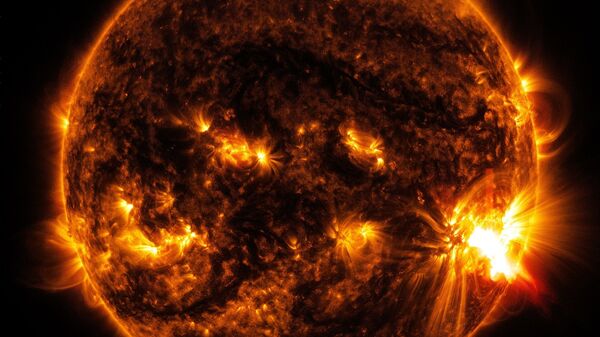The modern world could be plunged into chaos by a huge solar flare that destroys the Earth's technology, according to a new study exploring the risk to planets from eruptions on the surface of the Sun and other stars.
"You can think of it as an explosion of a magnitude of millions of nuclear bombs on the surface of the Sun," Professor Abraham Loeb, lead author of the study and Chair of Harvard Astronomy Department, told Radio Sputnik.
"The surface is very active, there are nuclear fields there and every now and then they snap and energize the surface with a powerful explosion that sends out energetic particles in the direction of the Earth."
Solar flares happen all the time, but larger ones have the potential to reach Earth and cause significant damage. For example, in 1859 a solar storm occurred after the Sun ejected large amounts of plasma and magnetic field which hit the Earth's own magnetic field. The resulting geomagnetic storm was one of the largest on record and caused telegraph systems to fail all over the world.
In 2011, the Earth experienced a near miss when a solar storm of a similar magnitude to that of 1859, also caused by a coronal mass ejection, missed the Earth's atmosphere by about nine days. Our total reliance on technology these days makes human civilization much more vulnerable to solar storms and this vulnerability will only increase, Loeb warned.
"In the past, these events were not recognized as dangerous or harmful because we didn't have much technology. Now, we have power grids, satellites, computerized systems which are very vulnerable to such powerful flares and so if an event like the Carrington Event that took place 150 years ago were to happen today it would cost the economy trillions of dollars."
"In the future, we are very vulnerable and we estimate that in 100-150 years it's quite likely that there will be a solar flare that will damage the economy at the level of tens of trillions of dollars, comparable to the GDP of the US."
"The longer you wait, the stronger and brighter the flare could be," and there is a ten percent chance that a solar flare comparable to that which occurred in 1859 will occur again over the next decade.
"These events occur at random, it's likely that we will have such an event within a hundred years and if we wait a thousand years, it will be much more powerful."
At the moment humans don't have any way of protecting the Earth from a solar storm, although the research paper written by Loeb and his colleague Manasvi Lingam of the Harvard-Smithsonian Center does make a suggestion, albeit costly.
"One thing we can do is to mitigate the damage. In the paper, we propose a way to do that by placing, basically a wire loop in between us and the Sun that generates a magnetic field that would deflect those energetic particles. One could also think about mitigation methods on Earth."
"Given how long it took for people to get used to the idea of climate change," it might take a similarly long time for people to take the threat of solar flares seriously. However, "nature has its way of showing us the truth eventually," Loeb said.
"Eventually the damage will occur, there will be a flare that causes a lot of damage and there will be another one and it will become obvious that we need to do something about it. I'm not worried that eventually there will be awareness. The question is, how many storms are needed to trigger the attention of the political system?"





